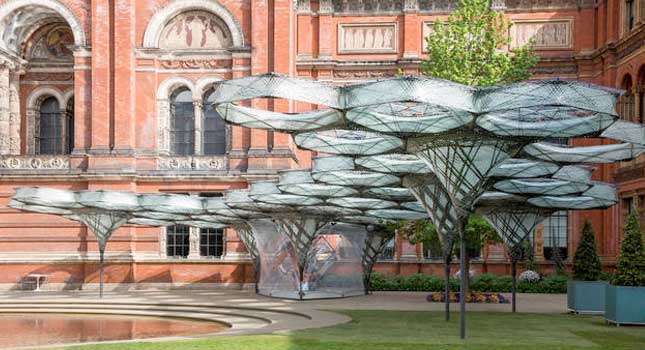
What the heck is the Elytra Filament Pavilion?
Luckily, it’s not necessarily a part of a Skynet-inspired singularity event beginning with the London museum scene. Instead it’s a cool pavilion set in the John Madejsky Courtyard of the V&A that has been built by a relatively benign, but advanced robotic arm that looks like it’s been taken directly out of a Honda car advert.
It’s a part of the Victoria And Albert Museum’s Engineering Season and has apparently been designed to take a cheeky look at the impact of ongoing developments in robotics on architecture, technology and the process of manufacturing and construction. It’s the work of a team of crack architects and engineers from the University Of Stuttgart in a case of large scale biomimicry that draws its inspiration from elytra, the forewing shells of flying beetles.
The Kuka robot that has put it all together uses a revolutionary robotic winding technique to create the cells that make up the Elytra Filament Pavilion. Sensors in the cells will then track the movement of visitors to the display and the data that is collected will be used to guide the ongoing development of the pavilion during its time at the V&A. The Kuka robot will then become a part of the display during special events where visitors will be able to see the robot in full flow creating new cells to add to the pavilion. Visit the Museum’s what’s on page to keep an eye out for the Kuka robot construction day events.
When’s it on?
The Elytra Filament Pavilion opened at the Victoria And Albert Museum on the 18th May 2016 and will be on display throughout the summer and autumn months before coming to a close on the 6th November 2016. We’re hoping that Kuka will also have to deal with dismantling the pavilion, as well as building it, but we suspect it’ll need a bit more human intervention at that stage.
As with all V&A displays, the pavilion is free to enter and as it’s located out in the John Madejsky Courtyard, so it’ll be open to drop in to see the futuristic design for yourself. The Museum is open from 10am to 5.45pm daily and then from 10am until 10pm on Fridays if you’re looking to catch the pavilion lit up with the twilight backdrop of the V&A.


